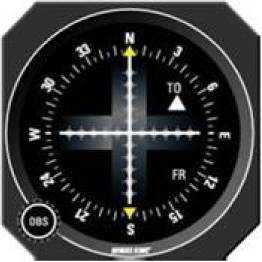Aero-Tips!
A good pilot is always learning -- how many times have you heard
this old standard throughout your flying career? There is no truer
statement in all of flying (well, with the possible exception of
"there are no old, bold pilots.")

Aero-News has called upon the expertise of Thomas P. Turner,
master CFI and all-around-good-guy, to bring our readers -- and us
-- daily tips to improve our skills as aviators. Some of them, you
may have heard before... but for each of us, there will also be
something we might never have considered before, or something that
didn't "stick" the way it should have the first time we memorized
it for the practical test.
Look for our daily Aero-Tips segments, coming each day to you
through the Aero-News Network.
Aero-Tips 08.24.06
 Here's the secret to flying a
smooth, accurate instrument approach: the Course Deviation Needle
(CDI) and glideslope indicator are not the focus of your scan.
Here's the secret to flying a
smooth, accurate instrument approach: the Course Deviation Needle
(CDI) and glideslope indicator are not the focus of your scan.
The Needles
Flying a precision or nonprecision approach, you follow a course
along the ground as displayed on your navigation head, Horizontal
Situation Indicator (HSI) or glass-cockpit equivalent. In almost
all current technologies this display consists of a CDI needle that
travels (or swings) left and right of center. Keep the needle
centered and you're on the displayed course. If the needle is to
the left you need to go left, if it's to the right you need to go
right (unless your indicator is a configuration that results in
"reverse sensing").
Similarly, a precision approach (by definition, one that
includes vertical guidance) includes a glideslope indicator with a
needle or pointers. If the needle/pointer is centered you're on the
glideslope, if it's above center you're low and if it's below
center you're high.
The CDI and glideslope needles, then, tell us our current
position relative to the approach. But they do not tell us whether
or how long we're going to stay that way. Simply "flying toward the
needles" to keep them centered as they move condemns the pilot to a
high-workload, passenger-sickening approach as he/she chases them
back and forth. In addition to current position information, a safe
and smooth approach requires we know and use performance trend as
well.
Trend Information
The CDI may be centered and show us on the courseline, but we
need to know if our trend is to remain on the course. This requires
we know the aircraft heading. If heading is aligned with the
selected course, plus or minus wind correction, then not only does
a centered needle mean you are on track, but it also means you'll
keep the needle centered as you progress. If the needle is to the
left but your heading is still the published inbound course, you'll
only get farther from the courseline as you get closer to the
airport and the course width narrows (for ground-transmitted course
data). To re-intercept you'll need to change heading slightly
toward the needle (the amount of heading change is dependent on the
amount of needle displacement and your distance from the signal
transmitter)…you need to establish a trend back toward the
course. When the needle re-centers, change heading back to inbound
(with wind correction as needed) for a trend to remain on
course.
A centered glideslope needle means you're currently on the
glidepath between intercept and the Final Approach Fix (FAF). But
will you stay on glidepath, or will you end up high or low? To
answer you need to know the vertical speed. At most lightplane
approach groundspeeds it takes between 500 and 600 foot per minute
descent to remain on the typical three-degree glideslope. If the
needle is centered but your rate of descent is only 300 fpm, you'll
soon be above glideslope. Lower the pitch or reduce power slightly
to increase rate of descent. If you're already above glideslope,
increase vertical speed to, say, 700-800 fpm to reacquire
glideslope, and when the needle centers re-set pitch and power for
a 500-600 fpm descent. If you're below glideslope raise the
nose/increase power to fly level until the needle again centers,
then re-establish your normal pitch and power to remain on
glideslope. Throughout, you're using vertical speed to determine
your trend to remain on or return to glideslope.
Smooth, low-workload instrument approaches come not from chasing
needles, but from flying basic attitude flight-heading and vertical
speed-while scanning the CDI and glideslope to gauge the
effectiveness of attitude instrument flying. Watch the flight
instruments, scan the needles. This is backward from the way most
of us are taught to fly approaches (watch the needles, scan the
instruments).
Aero-tip of the day: Evaluate position and
trend to fly smooth, low-workload approaches.
 SpaceX to Launch Inversion RAY Reentry Vehicle in Fall
SpaceX to Launch Inversion RAY Reentry Vehicle in Fall Aero-News: Quote of the Day (04.23.24)
Aero-News: Quote of the Day (04.23.24) Aero-News: Quote of the Day (04.20.24)
Aero-News: Quote of the Day (04.20.24) ANN's Daily Aero-Linx (04.20.24)
ANN's Daily Aero-Linx (04.20.24) Aero-News: Quote of the Day (04.21.24)
Aero-News: Quote of the Day (04.21.24)




